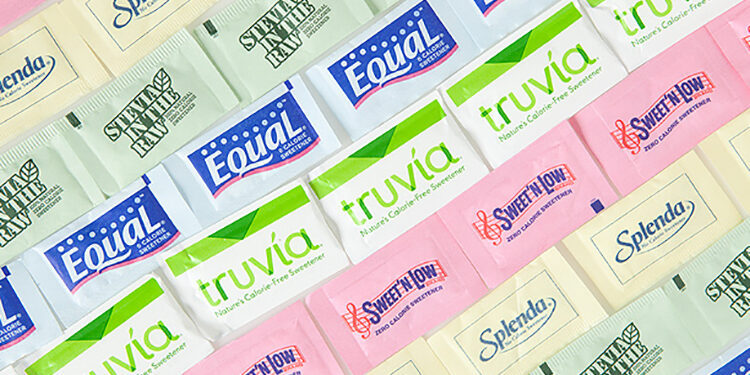Have you noticed that the array of beverage sweeteners at the coffee shop is slowly but surely growing? Where there used to be a couple of artificial sweeteners and sugar, there are now a plethora of packets, as well as a growing number of syrups. How are we supposed to figure out which is healthy, and which is not? I went to work, and I think I’ve figured out a way to make this super simple for you. Keep in mind that there is a plethora of other sweeteners that I love for baking such as black strap molasses and raw honey, but for this blog, I am covering the kinds of sweeteners that you see in a coffee shop, or pop in your purse (individual packets) when you go out to sweeten your drink.
Here’s my best to worst line-up (#1 being the best).
1. 100% organic Stevia or Monk Fruit: Make sure that you are getting 100% stevia leaf or monk fruit powder and that it’s not mixed with any other ingredients. I like Sweet Leaf Stevia, which comes in powder or drops.
2. Raw Brown sugar: Although sugar will spike your blood sugar, and is thus not suitable for diabetics, it is better off than the artificial sweeteners listed below because it doesn’t come with the same health concerns. Moreover, brown sugar is less sweet and thus a better way to go if you are trying to wean yourself off the uber-sweet taste of the artificial stuff. Although I try to avoid sugar in my diet, if I had to choose between the regular sweetener line-up at the coffee shop, I’d chose a little sugar.
3. Truvia: A better choice may be Truvia, however it’s important to note that it’s not really made from the whole stevia leaf (as it’s marketed to be). The 3 ingredients are: Erythritol (a sugar alcohol), Rebiana (a molecule of the Stevia plant, but NOT actual stevia leaf, and Natural Flavorings. Maybe not as healthy as we’re led to believe, right?
4. Stevia-in-the-Raw: This is made from the actual stevia leaf, but do note that it also contains corn-derived dextrose and maltodextrin, which I would choose to avoid because I don’t want corn-anything with my stevia.
5. Artificial non-caloric chemical sweeteners: And now we move on to the chemicals. While not as horrendous in the health department as many of us have been led to believe – the jury’s out on the long-term health effects, and I just don’t love the idea of filling my drinks and body with chemicals period. Sweet N’Low (saccharin) is the pink packet, and although studies connecting this sweetener to bladder cancer in rats in the seventies has been dis-proven, it is still a chemcial. Splenda (sucralose) is a similar chemical sweetener. Studies have pointed out that there could be some health issues connected with consuming Splenda. This artificial sweetener may be a migraine trigger. So if you suffer from migraines or frequent headaches, cutting it out may ease your pain. Equal & Nutra Sweet the final in the line up of chemical sweeteners is made from aspartame, and it has been linked to headaches, and, and feeling generally unwell. If you are in any doubt about this sweetener, especially if you suffer from migraines – try avoiding it and see if you feel better.
Sugar syrups are to be used in moderation. Whether you are using liquid sugar or Agave syrup, it’s still going to spike your blood sugar, and those syrups mix so well with beverages that you have to really watch out. When you are at the coffee shop, ALWAYS ask for unsweetened (which means they won’t pump your drink with syrup), and if you need to have it sweeter, just add a pack of pure stevia, or if you hate the taste (and you’re not diabetic), a dab of raw sugar.
It’s super important to understand that 100 years ago we didn’t have artificial sweeteners or stevia/monk fruit – all of which are 200-600 x sweetener than brown sugar. And guess what? We also didn’t suffer from obesity. I strongly believe that the extreme sweetness of these new sweeteners is not a healthy thing because it’s not natural. The sweetness that you taste in a piece of fruit is natural, and now we’ve become so used to the off-the-charts sweetness of these powders, our taste buds no longer register the sweetness of a sugary fruit such as a grape. Therein lies the problem. This artificial sweetness also alerts our brain to the fact that we are consuming, or about to consume vast amounts of calories (that correlate with the sweet taste) – this triggers our brain to send out hunger signals for high calorie sweets. This is perhaps the reason why artificial sweeteners have been linked to obesity.
My recommendation is to try to wean yourself off sweeteners all together. If you normally use 2 packets of sweetener, use 1, or even half a packet. Your best case scenario, if you are not diabetic, is to use a little raw honey or brown sugar and you’ll be good go
And most importantly, if you make sure that you eat a varied diet full of fresh fruits, veggies, seeds and nuts, you are unlikely to crave the uber-sweetness that we are getting so used to.




Pingback: Stephen